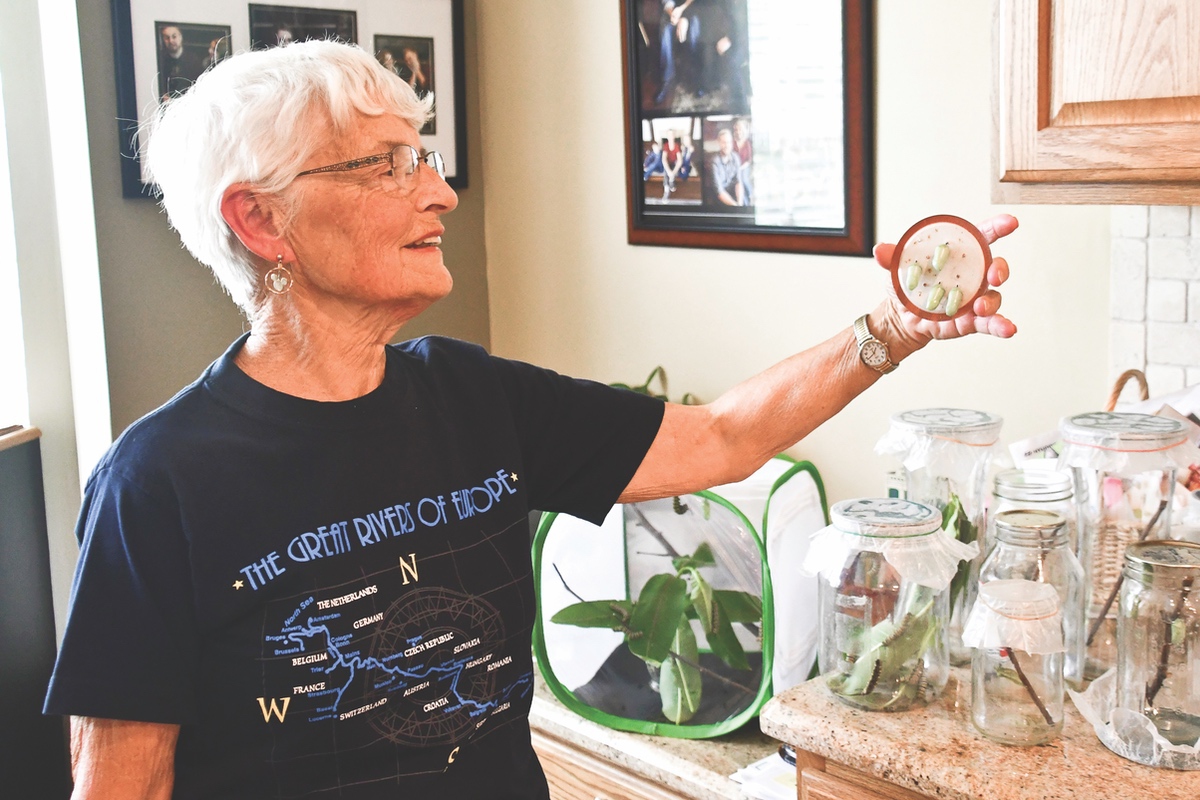You may know Janet Graf from her stunning performances in the Sun City’s theatre productions. Outside of the theatre, Graf raises Monarchs. This year she has released around 95 butterflies.
“I find the eggs on a milkweed leaf, I break the leaf off and I put them in a glass container on my counter,” Graf said.
Where does Graf find the butterflies?
“I find them mostly in my yard,” she said. “I have taken walks in the wilderness in Sun City, but I have never found any eggs on the milkweed. The leaves seem to be a little courser than the ones in my yard. The caterpillars eat those courser leaves, but I have not found eggs on them.”
The work involved in raising Monarchs might be surprising.
Graf said, “It is a tedious process that involves washing, cleaning the jars twice daily, to keep the bacteria at bay and they eat a lot of leaves.”
Graf has been raising butterflies for quite some time.
Graf said, “It started when my daughter was 10 years old. She collected bugs. I was involved in Girl Scouts and on camping trips, I would introduce them to the task. My daughters still love raising them, and now my grandchildren love it also.”
Graf said, “I use to catch fireflies also. I kept in a jar in a refrigerator in the garage to keep them dormant. I would get paid for them. Kids in the neighborhood used to catch them for me and I would pay them a penny for each one. I made only about $50 for the season, but it was fun.”
Substances that produce the firefly`s flashing light are used in medical research to study diseases such as cancer, multiple sclerosis, and heart disease, and also to test the bacterial content in water and milk.
Graf hasn’t only housed Monarchs in her butterfly home.
“Sometimes I find eggs for Red admirals, Painted Ladies, or a Yellow Tiger Swallowtail,” she said.
Once the butterflies reach the metamorphosis stage, they spend about 10 days in a jade-colored chrysalis before emerging as a full-grown monarch butterfly.
Graf said, “The caterpillars survive by eating the milkweed leaves. They grow in size until they’re ready to create chrysalides. I know that they are ready when they hang in a ‘J’ form. They turn a little greener. They stay in these green homes for 10 to 14 days and hatch as full-grown monarchs.”
Just before they pupate, monarch larvae spin a silk mat from which they hang upside down by their last pair of prolegs. The total time from egg to butterfly is about 30 days.
Graf has a dozen homes for her guests.
“Right now I have around 30 caterpillars and 25 chrysalides,” she said.
Graf’s passion for raising the butterflies has been contagious. Graf said, “After seeing my collection, a few of my friends have decided to take on the hobby.”
Studies have indicated that wild monarchs have a mortality rate of about 90 percent between their egg stage and adulthood. But raising them decreases that rate drastically to about 8 percent. Monarch numbers are in decline in North America, and there is a petition on the U.S. Fish and Wildlife Service website to consider it for endangered status.






26 Comments
To the mysundaynews.com admin, Your posts are always on point.
Hi mysundaynews.com webmaster, Great content!
Dear mysundaynews.com admin, Thanks for the well-presented post!
Hello mysundaynews.com webmaster, Good job!
Hello mysundaynews.com owner, Thanks for the post!
Dear mysundaynews.com administrator, Your posts are always well-supported by facts and figures.
Hi mysundaynews.com admin, You always provide great examples and case studies.
Hi mysundaynews.com administrator, Great post!
To the mysundaynews.com admin, Thanks for the informative post!
Dear mysundaynews.com administrator, Thanks for the well-written and informative post!
Hi mysundaynews.com webmaster, Your posts are always well-referenced and credible.
Hello mysundaynews.com webmaster, Thanks for the well-researched and well-written post!
Dear mysundaynews.com administrator, Your posts are always informative and well-explained.
To the mysundaynews.com owner, Your posts are always well structured and easy to follow.
Hi mysundaynews.com administrator, Your posts are always on topic and relevant.
Hi mysundaynews.com admin, Your posts are always informative and up-to-date.
To the mysundaynews.com admin, Your posts are always well-written and easy to understand.
To the mysundaynews.com admin, Your posts are always well-supported and evidence-based.
Dear mysundaynews.com admin, Thanks for the valuable information!
Hi mysundaynews.com webmaster, Thanks for the educational content!
Hello mysundaynews.com webmaster, Keep sharing your knowledge!
To the mysundaynews.com administrator, Thanks for the detailed post!
Hello mysundaynews.com admin, Your posts are always well-structured and logical.
Hi mysundaynews.com webmaster, Thanks for the in-depth post!
To the mysundaynews.com administrator, You always provide great examples and real-world applications, thank you for your valuable contributions.
Hi mysundaynews.com webmaster, Great job!